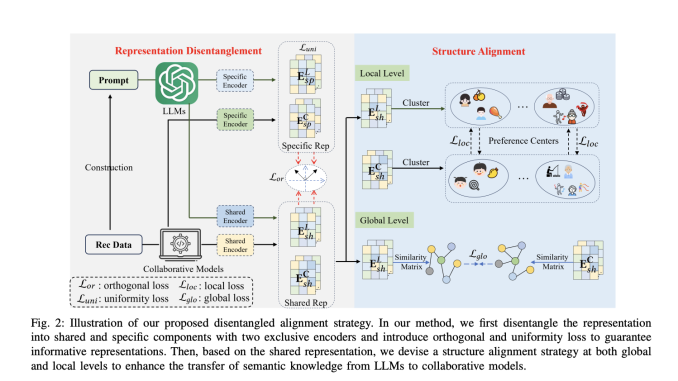
Recommender systems have gained prominence across various applications, with deep neural network-based algorithms showing impressive capabilities. Large language models (LLMs) have recently demonstrated proficiency in multiple tasks, prompting researchers to explore their potential in recommendation systems. However, two main challenges hinder LLM adoption: high computational requirements and neglect of collaborative signals. Recent studies have focused on semantic alignment methods to transfer knowledge from LLMs to collaborative models. Yet, a significant semantic gap persists due to the diverse nature of interaction data in collaborative models compared to the natural language used in LLMs. Attempts to bridge this gap through contrastive learning have shown limitations, potentially introducing noise and degrading recommendation performance.
Graph Neural Networks (GNNs) have gained prominence in recommender systems, particularly for collaborative filtering. Methods like LightGCN, NGCF, and GCCF use GNNs to model user-item interactions but face challenges from noisy implicit feedback. To mitigate this, self-supervised learning techniques such as contrastive learning have been employed, with approaches like SGL, LightGCL, and NCL showing improved robustness and performance. LLMs have sparked interest in recommendations, with researchers exploring ways to integrate their powerful representation abilities. Studies like RLMRec, ControlRec, and CTRL use contrastive learning to align collaborative filtering embeddings with LLM semantic representations.
Researchers from the National University of Defense Technology, Changsha, Baidu Inc, Beijing, and Anhui Province Key Laboratory of the University of Science and Technology of China introduced a Disentangled alignment framework for the Recommendation model and LLMs (DaRec), a unique plug-and-play framework, addresses limitations in integrating LLMs with recommender systems. Motivated by theoretical findings, it aligns semantic knowledge through disentangled representation instead of exact alignment. The framework consists of three key components: (1) disentangling representations into shared and specific components to reduce noise, (2) employing uniformity and orthogonal loss to maintain representation informativeness, and (3) implementing a structural alignment strategy at local and global levels for effective semantic knowledge transfer.
DaRec is an innovative framework to align semantic knowledge between LLMs and collaborative models in recommender systems. This approach is motivated by theoretical findings suggesting that the exact alignment of representations may be suboptimal. DaRec consists of three main components:
Representation Disentanglement: The framework separates representations into shared and specific components for collaborative models and LLMs. This reduces the negative impact of specific information that may introduce noise during alignment.
Uniformity and Orthogonal Constraints: DaRec employs uniformity and orthogonal loss functions to maintain the informativeness of representations and ensure unique, complementary information in specific and shared components.
Structure Alignment Strategy: The framework implements a dual-level alignment approach:
Global Structure Alignment: Aligns the overall structure of shared representations.
Local Structure Alignment: It uses clustering to identify preference centres and aligns them adaptively.
DaRec aims to overcome the limitations of previous methods by providing a more flexible and effective alignment strategy, potentially improving the performance of LLM-based recommender systems.
DaRec outperformed both traditional collaborative filtering methods and LLM-enhanced recommendation approaches across three datasets (Amazon-book, Yelp, Steam) on multiple metrics (Recall@K, NDCG@K). For instance, on the Yelp dataset, DaRec improved over the second-best method (AutoCF) by 3.85%, 1.57%, 3.15%, and 2.07% on R@5, R@10, N@5, and N@10 respectively.
Hyperparameter analysis revealed optimal performance with cluster number K in the range [4,8], trade-off parameter λ in the range [0.1, 1.0], and sampling size N̂ at 4096. Extreme values for these parameters led to decreased performance.
t-SNE visualization demonstrated that DaRec successfully captured underlying interest clusters in user preferences.
Overall, DaRec showed superior performance over existing methods, demonstrating robustness across various hyperparameter values and effectively capturing user interest structures.
This research introduces DaRec, a unique plug-and-play framework for aligning collaborative models and LLMs in recommender systems. Based on theoretical analysis showing that zero-gap alignment may not be optimal, DaRec disentangles representations into shared and specific components. It implements a dual-level structure alignment strategy at global and local levels. The authors provide theoretical proof that their method produces representations with more relevant and less irrelevant information for recommendation tasks. Extensive experiments on benchmark datasets demonstrate DaRec’s superior performance over existing methods, representing a significant advancement in integrating LLMs with collaborative filtering models.
Check out the Paper. All credit for this research goes to the researchers of this project. Also, don’t forget to follow us on Twitter and join our Telegram Channel and LinkedIn Group. If you like our work, you will love our newsletter..
Don’t Forget to join our 49k+ ML SubReddit
Find Upcoming AI Webinars here
Asjad is an intern consultant at Marktechpost. He is persuing B.Tech in mechanical engineering at the Indian Institute of Technology, Kharagpur. Asjad is a Machine learning and deep learning enthusiast who is always researching the applications of machine learning in healthcare.






Be the first to comment